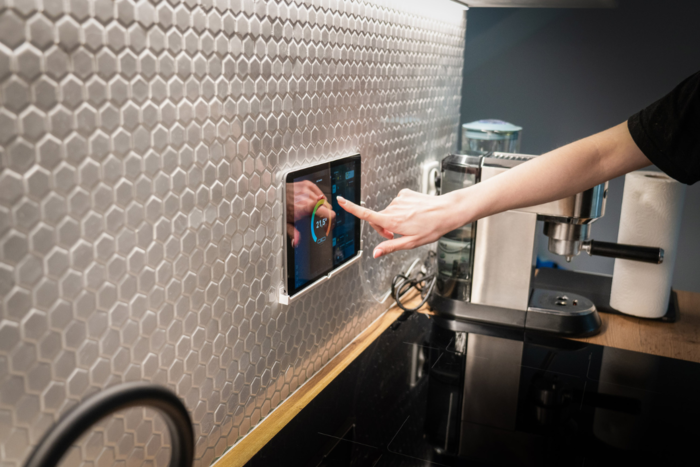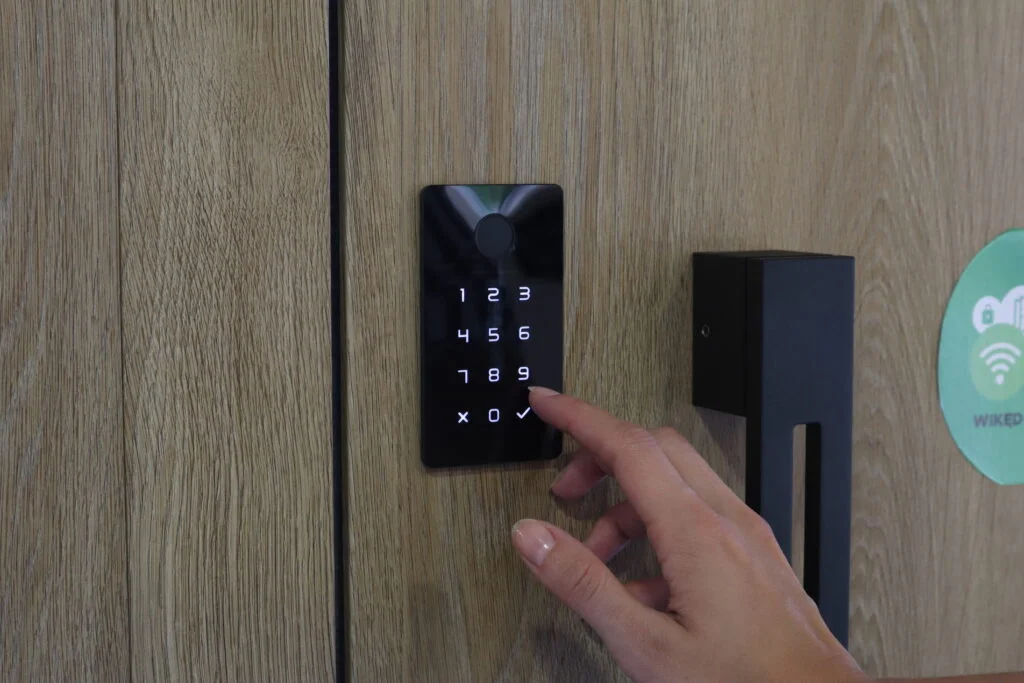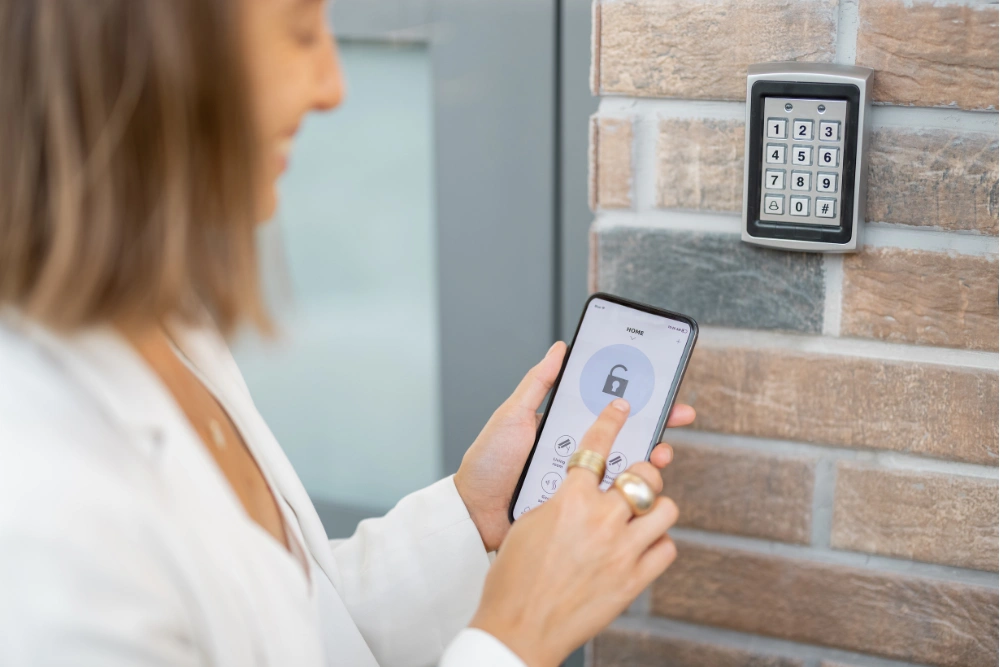A smart home is a connected living environment where devices such as lighting, heating, security systems and household appliances can be centrally managed or controlled remotely via the internet. With growing interest in home automation, more and more homeowners are embracing technology that enhances comfort, improves energy efficiency and increases security. At Fenbro, we recognise the importance of staying ahead in this shift towards smarter living. That’s why we offer modern home solutions that support smart integration – including doors equipped for advanced access control and automation features.
Want to know how smart living works and why it matters? Let’s dive in!
What makes a home ‘smart’?
A connected home integrates building technology and appliances in such a way that routines can be automated and centrally managed. Thanks to the Internet of Things (IoT), smart devices communicate with each other and take over tasks such as lighting control, heating regulation or security monitoring or even unlocking your front door remotely. While in the past only individual devices were networked, today the focus is on holistic systems that link lighting, climate, security, and household appliances.
How does a Smart Home work?
A smart home relies on smart home technology that connects various components, allowing them to communicate and automate routines.
- End devices (actuators) – smart lamps, blinds, radiator thermostats, or household appliances carry out the desired actions.
- Control devices – smartphones, tablets, touchscreens, or voice assistants such as Alexa and Google Assistant allow users to control the system.
- Sensors – these measure temperature, brightness or motion and trigger appropriate actions.
- Gateway – the central control unit processes sensor data, sends commands to actuators and coordinates communication between devices.
- Types of network – connectivity is mainly established via wireless protocols such as Wi-Fi, ZigBee or Z-Wave. Most households use Wi-Fi because it’s widely available and easy to set up. ZigBee and Z-Wave, however, offer more reliable connections, lower energy consumption and greater range, making them particularly suitable for larger or more complex systems.
 This interplay allows smart homes to be individually tailored and controlled in real time – either manually via a smart home app or voice command, or automatically based on predefined routines.
This interplay allows smart homes to be individually tailored and controlled in real time – either manually via a smart home app or voice command, or automatically based on predefined routines.
How can you control a Smart Home?
You can control a connected home in a variety of ways:
- Traditional switches and touchscreens offer direct control – often without users even realising that smart technology is behind it.
- Mobile control via app – smartphones or tablets enable remote operation, even when away from home.
- Voice control – voice assistants like Alexa, Google Assistant or Siri provide an intuitive interface.
- Automation – sensors handle routines such as turning on lights or regulating temperature.
- Access solutions – keycards, proximity readers or fingerprint sensors manage entry and can automatically switch off unnecessary power consumers.
Many homeowners also opt for keyless door locks or electronic door locks as part of modern home security solutions.
Which areas of your home can benefit from smart technology?
Lighting – intelligent light control
Smart lighting systems can be controlled via app, scheduled timers or motion sensors. Dimmable LED bulbs adjust colour temperatures and save energy through automatic switch-off features.
Heating & climate – efficient room temperature regulation
Smart thermostats regulate heating based on weather, time of day and occupancy. Intelligent ventilation systems improve air quality using CO₂ and humidity sensors.
Household appliances – automation for more comfort
Smart fridges monitor food stocks, washing machines adjust programmes to the load, and robotic vacuum cleaners clean autonomously.
Multimedia and entertainment – smart connectivity
Connected speakers and TVs allow central control of media content. Music can be synchronised across rooms, and TVs can be operated via voice command.
Security – protection through intelligent technologies
Smart surveillance cameras, fingerprint-enabled smart locks for home, and alarm systems boost home security. Smoke and water detectors provide early warnings in case of danger. At Fenbro, we provide doors compatible with smart locks, proximity readers and keyless access – making it easier to integrate your entrance into a complete home security solution.
What are the main benefits of Smart Home automation?
A smart home offers a wide range of advantages that simplify everyday life while maximising both comfort and safety.
Enhanced comfort
Automated processes reduce the need for manual intervention. Whether it’s light control, temperature adjustment, or automated doors and smart door locks that can be operated via app, or intelligent appliances – many tasks run automatically and adapt to the residents’ individual needs.
Energy efficiency and cost savings
Smart heating and lighting systems can reduce energy bills. Sensors and self-learning control units help optimise energy consumption by ensuring heating and lighting are only used when truly necessary.
Increased security
Smart locks, alarm systems and surveillance cameras improve safety, even remotely. Many systems can be operated via smart home apps and instantly notify users of unusual activity.
Time savings
You can automate routine tasks like vacuuming, garden irrigation and temperature control. This reduces daily effort and gives residents more time for other priorities.
What are the risks and challenges of smart home technology?
Despite its many benefits, smart home technology comes with a few important challenges to consider:
- Data protection and cybersecurity – without proper security, smart devices may be vulnerable to hacking or data misuse.
- Dependence on internet and software – Connectivity or software failures can disrupt key smart home functions.
- High setup and installation costs – Initial investment can be expensive, though starting small helps spread the cost.
- Compatibility issues between brands – Devices from different manufacturers may not always work together smoothly.
Careful planning and the right product choices help minimise many of these risks.
The future of digital living
Smart home technology will increasingly rely on artificial intelligence and machine learning to recognise daily routines, predict needs and make independent decisions that enhance comfort and convenience. Appliances, lighting and security systems will work together more seamlessly, adapting in real time to users’ habits.
Sustainability will also be key. Energy-efficient heating, smart grids and solar panels will help reduce consumption, while smart ventilation, air quality sensors and health trackers will support wellbeing.
Looking ahead, smart homes will form part of larger ecosystems – integrated with Smart Cities and intelligent energy networks – making homes not only safer and more comfortable, but also greener and better connected.
Are Smart Homes always a good idea? Pros and cons explained
Smart homes can make everyday life easier, but they’re not without drawbacks. Devices collect a lot of personal data, and if not properly protected, that information could end up in the wrong hands. Most systems also rely on a stable internet connection and power supply, so when those fail, so can your heating, lighting or security. And while smart tech promises savings in the long run, the upfront costs and ongoing fees don’t always pay off – especially if you’re not using all the features regularly. That’s why it’s worth weighing the comfort and convenience against the potential risks before diving in.
Control your entrance with WIKĘD smart technology
WIKĘD SMART is an advanced smart lock system that lets you open and close your door remotely, check its lock status from anywhere, and control entrance lighting via smartphone – all integrated into your smart home setup. Based on microWiFi and compatible with standard Wi-Fi, it offers encrypted access, a full event history, access scheduling, and easy expansion for growing needs.
For keyless access, the Proximity Reader allows you to unlock smart doors using key cards, fobs or even your car key – supporting up to 150 authorised users. It’s a practical addition for families or shared properties.
If you’re looking for maximum flexibility, the MULTI SMART control system combines a fingerprint reader, code keypad and RFID access into one device. It works with smartphones, Bluetooth and physical credentials, making it a comprehensive solution for secure and convenient entry.
Interested in adding smart technology to your home? Explore our selection of smart home solutions and feel free to contact our Sales Team for tailored support.
Conclusion – is a Smart Home worth it?
A well-planned smart home can bring real benefits – more comfort, better energy use and added security. But to make it truly work for you, it’s important to think about what features you actually need, whether your devices will be compatible, and how you’ll keep everything secure and up to date. Also consider your home layout, internet stability and how tech-savvy you (or your household) are – these things can really affect your experience. You don’t have to go all in from day one – starting small and expanding over time is often the smarter (and more affordable) route. With the right setup, smart living really can make everyday life easier – and undoubtedly more enjoyable.
Frequently Asked Questions (FAQ)
What is a smart home?
A smart home is a house where everyday devices are connected and can be controlled by mobile apps, voice or automatically.
What do you need for a smart home?
A gateway, smart end devices (e.g. lights, thermostats), and a stable internet connection.
Is a smart home secure?
Yes, provided you use strong passwords, two-factor authentication, and keep the software updated regularly.
Can a smart home be retrofitted?
Yes, many wireless devices can be added using Wi-Fi or Bluetooth.
Does a smart home work without internet?
Basic functions may still work offline, but many features require an online connection.
Is a smart home financially worthwhile?
Although the initial costs are high, energy and heating savings over time can make it a worthwhile investment.



